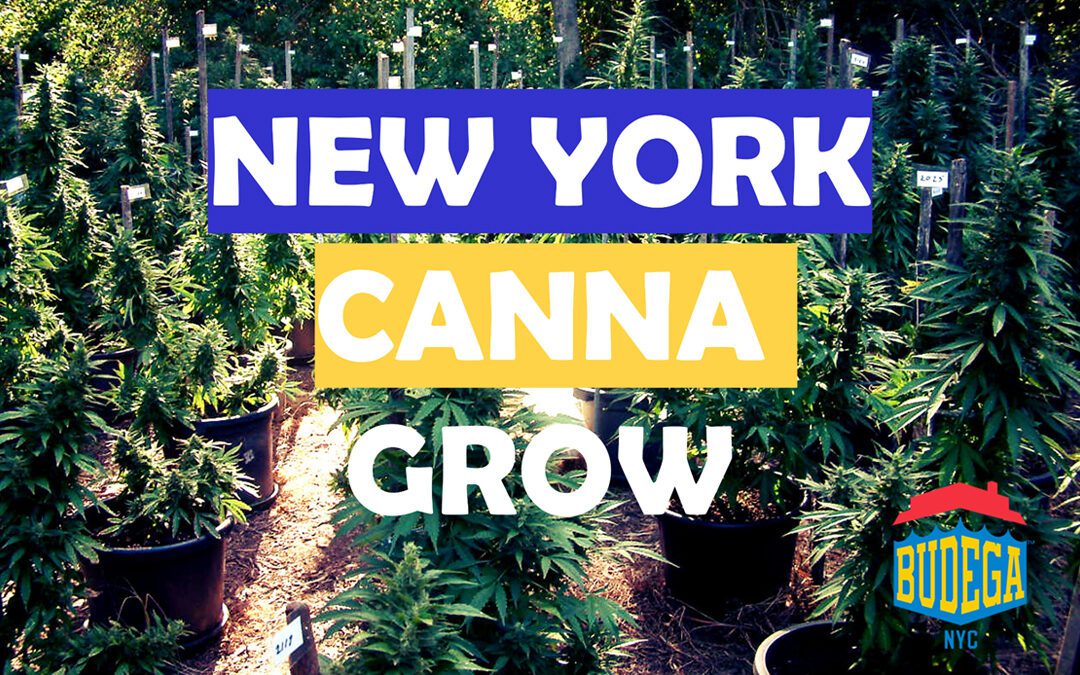There are several factors to take into account when planning a cannabis cultivation site. While the location and accessibility for equipment needed to cultivate are significant factors, the environment is most important. For the sake of this article and the proposed home grow provisions in New Jersey and New York, we will concentrate on small grow spaces.
Providing the best possible climate for plants will guarantee a bountiful harvest. Some of the most significant factors affecting plant growth are light, nutrients, carbon dioxide, water, and temperature. These elements are essential for plant photosynthesis. If one of the elements is insufficient or off-balance, the plant’s growth rate, and ultimately the final product, will suffer. (Bugbee, 2020)
Indoor grow setups typically ensure optimal growing conditions because everything is controlled, including temperature, humidity, feeding, airflow, etc. However, indoor cannabis cultivation is among the nation’s worst offending greenhouse gas polluters. Indoor grows use 8-times as much electricity per square foot for lighting alone as the average U.S. office building uses for all purposes and 17-times as much as the average U.S. home. Lighting-related CO2 emissions are 1200-times the final product’s weight or about 3 pounds of CO2 emissions per “joint.” Budega NYC encourages growing cannabis with a focus on sustainable practices.
New York City Cannabis Cultivation Considerations – Limited Space
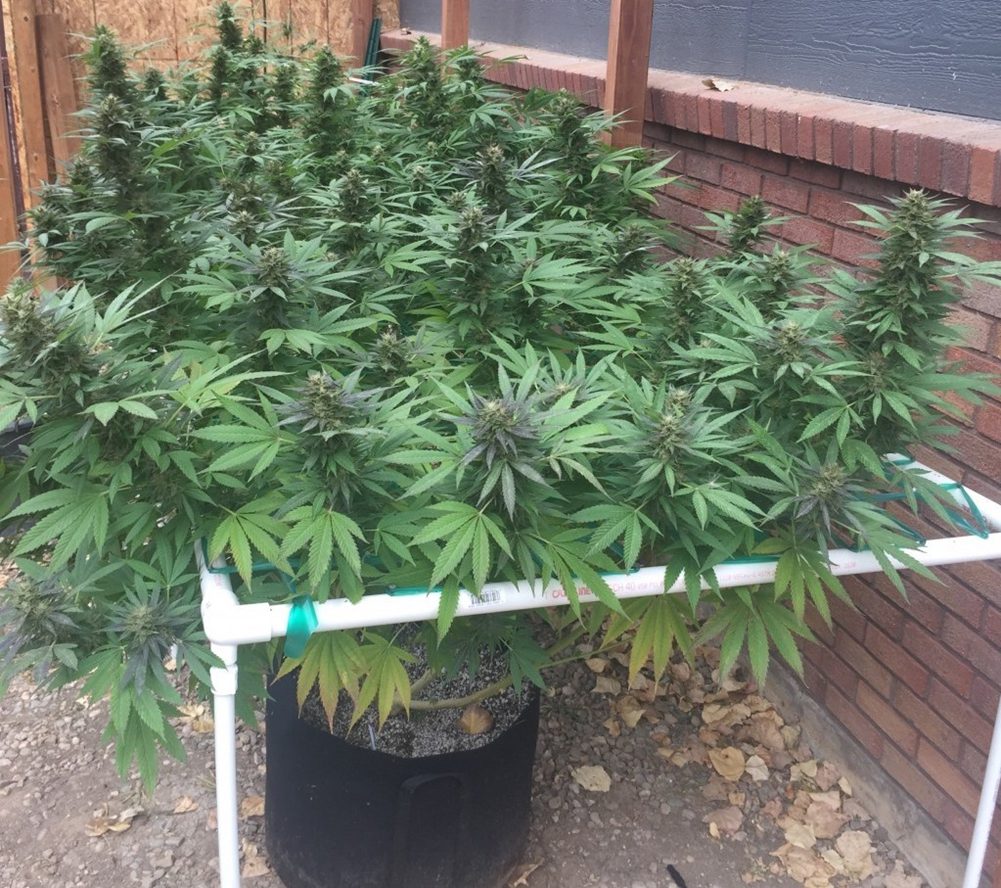
The first step in growing cannabis is identifying a grow site? When considering space requirements for cannabis cultivation, the good news is the plant doesn’t require much space to grow efficiently. “Cannabis is an eager plant that will grow nearly anywhere given the right light and nutrients, making a grow room of any size feasible” (Hennings, 2019).
It’s recommended to utilize a greenhouse for any outdoor cannabis grow for a variety of reasons. Greenhouses allow controlling the natural environment, particularly extreme weather conditions, pests, and prying eyes. Last but not least, outdoor recreational setups may be required to have a greenhouse, as is the case in New Jersey. Since cannabis needs high light levels for peak performance, a light audit of the site is required to ensure that the site collects the required Lux during “the 12 hour period.”
A light audit consists of checking light strengths several times throughout the day. Use of a standard Lux Light Meter will be required to determine if your site receives the necessary 50.000 – 75.000 Lux that is essential for cultivation during the flowering period. Greenhouse setups can utilize LED lights to supplement any potential light deficiencies.
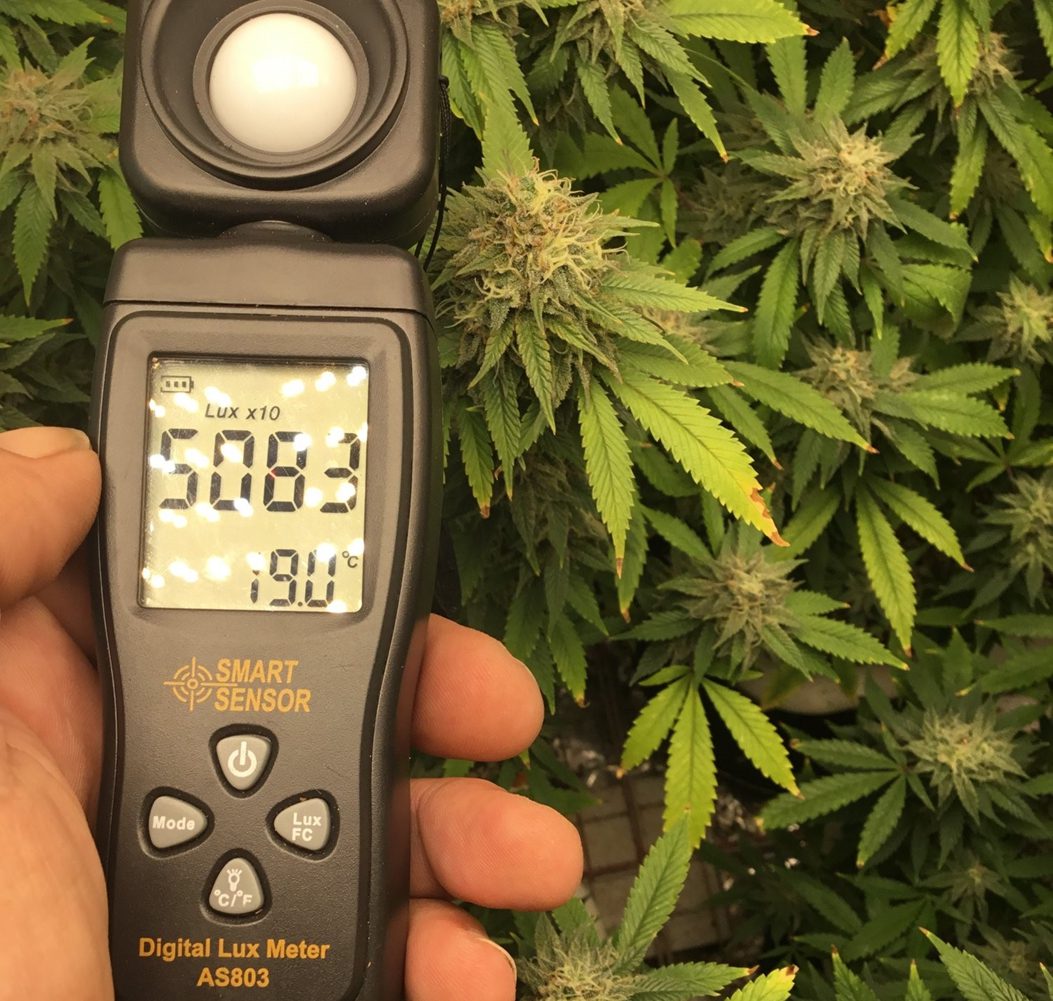
Indoor Grow Setup
Growing in small spaces has its benefits, including discreteness due to less equipment noise and a lesser number of plants emitting less smell. “A grow space can be as small as a 2′ x 2′ x 4′ grow tent or as big as a warehouse, but they all have several things in common” the first requirement is headspace. As the plant matures, it grows taller—requiring adequate space above the plant. Second, space needs to be sterilized from the outside world to create a climate best suited for the plants’ growth. Lastly, it needs a continual exchange of fresh air. With those three elements, a cannabis cultivation setup can prove successful anywhere that is available. (Hennings, 2019).
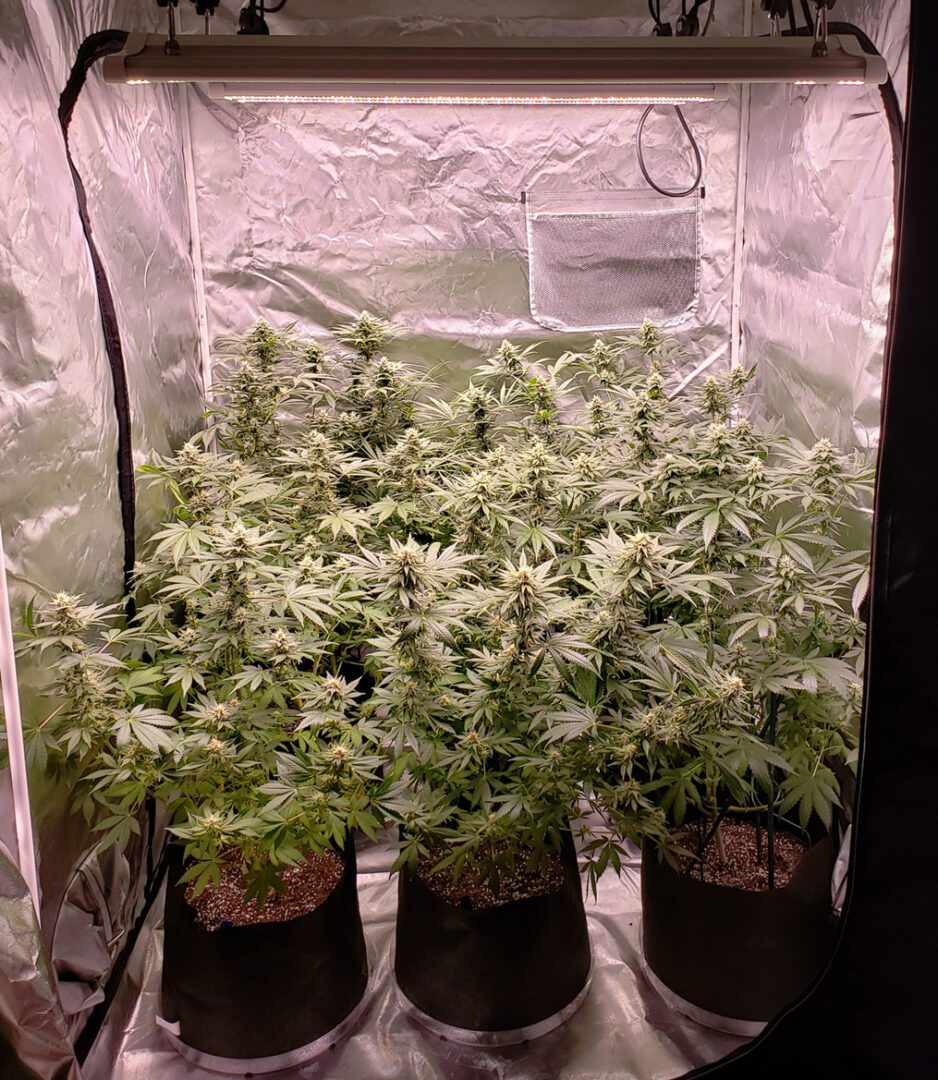
Cannabis needs high levels of light for peak performance. The plants use light from 350-750 nanometers on the light spectrum, including the U.V. and Far Red wavelengths. Light manufacturers have spent millions on researching the perfect spectrums for the bulbs they produce for the agricultural industry. To optimize growth, it is recommended that plants receive 500-1000 micromoles of photosynthetic active radiation (PAR) per meter squared but can receive 1500 plus if all other parameters are optimized. (Bugbee, 2020)
There are a variety of options when it comes to grow lights if sunlight is unavailable. Some commonly used indoor and greenhouse cultivation lights are high-pressure sodium (HPS), metal halide (M.H.), ceramic metal halide (CMH), and light-emitting diodes (LED). These would only be used as supplemental lighting in a greenhouse setting when the sun’s intensity does not provide enough light to support peak growth during days with shorter amounts of natural sunlight. (Cervantes, 2007)(Rosenthal, 2009)

Luxx 645w Led Pro
Organic soil is recommended for a variety of reasons. Organic soils can help cannabis plants avoid pests and disease, reducing the need for chemicals and pesticides. In addition, the nutrients and minerals in organic soil will help plants develop stronger cell walls, making them more resistant to pests and disease. There are two options when using organic soil. One option is building up the soil by composting, which requires some time and patience. The second option is buying ready-made organic soil. Either way, both options will require nutrient amendments to adjust for any deficiencies that the plants may exhibit. The former option may also require submitting a soil sample to identify said deficiencies.

Organic soil optimizes the flowering of a cannabis plant.
Cannabis prefers growing in soil between 6.0-7.0 on the P.H. scale and 5.5-6.8 for growing mediums such as coco coir, coco/peat mixes, or in hydroponics. The optimal temperatures range from 70-85 degrees Fahrenheit, depending on the stage of growth and strain. While in its vegetative state, plants prefer temperatures from 70-85 degrees Fahrenheit with a humidity level of 50-70 percent and a light cycle of 18 hours of daylight and six hours of complete darkness. When plants are flowering, the recommended climate is an average of 70-80 degrees Fahrenheit, with 40-60 percent humidity and a light cycle of 12 hours of sunlight and 12 hours of darkness.
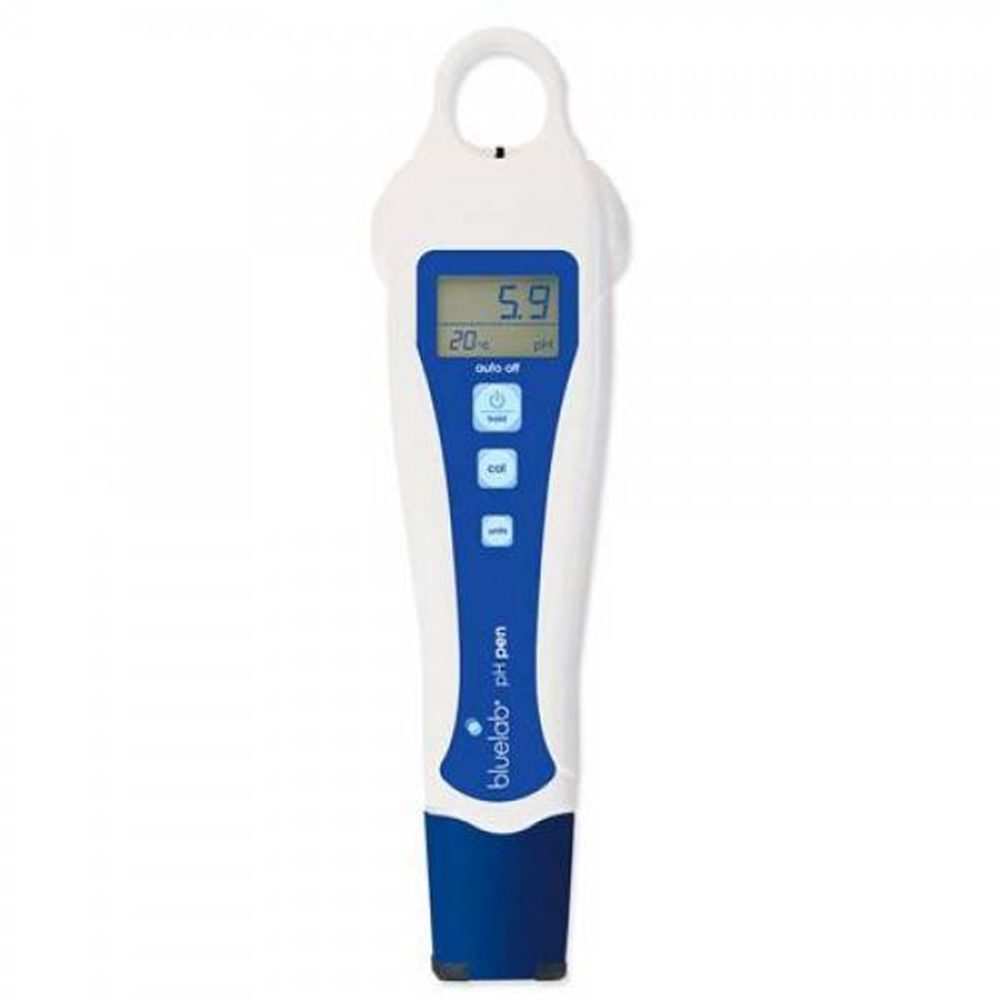
Bluelab pH pen
Any temperature above 85 degrees Fahrenheit will decrease the plant growth rate, and above 90 degrees Fahrenheit will stop plant growth altogether. Warmer temperatures can be offset using carbon dioxide at a rate of up to 1500 parts per million. Carbon dioxide aids plants in photosynthesis and can increase the plant’s yields by up to 30 percent. The need for water and nutrients will also increase as a result of the higher metabolic rate. (Cervantes, 2007) (Bugbee, 2020)
Airflow is essential to the health of the plants; once the plant reaches its vegetative state, a slight breeze from a fan should be gently moving the plants, simulating the wind blowing. This will help strengthen its stocks and prevent any powdery mildew from growing. If the humidity levels are too high and airflow is insufficient, problems will arise sooner than later.
All cannabis starts its life as a seed. Generally, seed packs will come with 10-13 seeds per pack. They are available as either regular or feminized seeds. Feminized seeds produce all females, which is necessary when cultivating cannabis buds. As for regular seed packs, sex will have to be determined as the plants mature. Sexing plants is straightforward: the female plants will produce pistils that appear as wispy white hairs, while males grow pollen sacs. If cultivating strictly for bud production, discard male plants as soon as they are identified to reduce seeding potential.

The next step is germination. There are several ways to germinate seeds. One popular method is wrapping seeds in a damp paper towel and placing them in a sealed plastic bag. After saturating a paper towel with water, remove any excess water and place the seeds in even intervals on the paper towel. Fold the paper towel in half and place it into the sealed plastic bag. Then, place the sealed plastic bag into a dark space for three to seven days, intermittently checking on the moisture of the paper towel and the progress of the seeds. Be sure not to over-saturate the towel. Seed starter plugs such as Root Riot, or Jiffy Cube, or Rock Wool may also be used if desired. (Rosenthal, 2009)
Hormones produced inside the seed signal the plant for more cellular formation and an increase in cell size. As the embryo expands, stored food inside the seed supports growth. Once the taproot emerges from the shell, place it into a small container with soil or preferred growing medium–taproot side down. The soil should be kept moist but not overwatered. To maintain strong, healthy growth, a light cycle of 18 hours with lights on and 6 hours of complete darkness must be maintained. Setting lights on a timer will prevent any deviation in the light schedule. A humidity dome can be used to maintain an optimal atmosphere.

The light intensity can be very low at this growth stage, as the plants are still young and adjusting to their growth cycle. No nutrients should be fed to the plant until the roots are well established and strong enough to digest them. The plant will feed off the nutrients in the soil for several weeks awaiting transplant into a larger pot. It will remain in the seedling stages for two to three weeks before entering its next stage of life. (Rosenthal, 2009)
As the plant matures and progresses into the vegetative stage, it will start to outgrow its original pot; a transplant should be executed. Gradually stepping up pot sizes help create a larger, more vital root mass leading to more robust and healthier plants. Feedings can begin as soon as the plant is transplanted. Half strength from bottle-feeding regiments is recommended, with the water and nutrients’ P.H. levels to be in the 6.3-6.5 ranges. Water should be warmer than 65 degrees Fahrenheit to prevent the shock of the root system and aid in nutrient uptake.

PPM meters indicate whether you are underfeeding or overfeeding your plants.
Cannabis plants prefer it on the warmer and more humid side at this stage of life: the optimal range is 75-80 degrees Fahrenheit and 60 percent humidity. The light intensity can be turned up without the risk of light stress as the plant has adjusted to its environment. The plant can remain in a vegetative state as long as the 18:6 light cycle is maintained. As the plant grows, the nutrient regiment and watering will have to be adjusted for the plants’ growth. Larger plants need more water and nutrients. Generally, they will stay in this stage anywhere from three to twelve weeks. (Rosenthal, 2009) (Cervantes, 2007)
After several weeks of vegetative growth, plants will start to exhibit signs of pre-flowering. The plant will have either exhibited white pistils for the females or pollen sacs for males. This is an indicator that the plants are ready to be placed into flowering. Plants can be transplanted into their final pot a few weeks before the initiation of the flower cycle. This will give the plant time to adjust before its final phase of life. The plant will start to flower after a few days of its new light cycle of 12 hours of light and 12 hours of darkness, commonly referred to as 12/12. It is imperative the dark cycle not be broken. Cannabis is negatively affected by any deviation from light schedules and can grow male pollen sacs or begin to revegetate if stressed. (Bugbee, 2020)
The flowering stage of the plants’ life can last on average six to nine weeks. This is mainly dependent on the genetics of the plant as well as the environmental conditions it is grown in. As the plants ease into flowering, temperatures should be around 70-80 degrees Fahrenheit, with humidity at around 50 percent. Flowering nutrient regimens can also start to be applied just before the light schedule changes.
Cultivators can train the plants to maximize space to set up cannabis cultivation in a small space for success. There are several ways to train a plant, including “scrogging. “This method is probably the best bet for getting a high return with minimal space. This process involves weaving the stalks and branches of a plant through a screen – mesh sizes usually range from three to six-inch squares – before switching to a flowering light cycle. (Hennings, 2019).
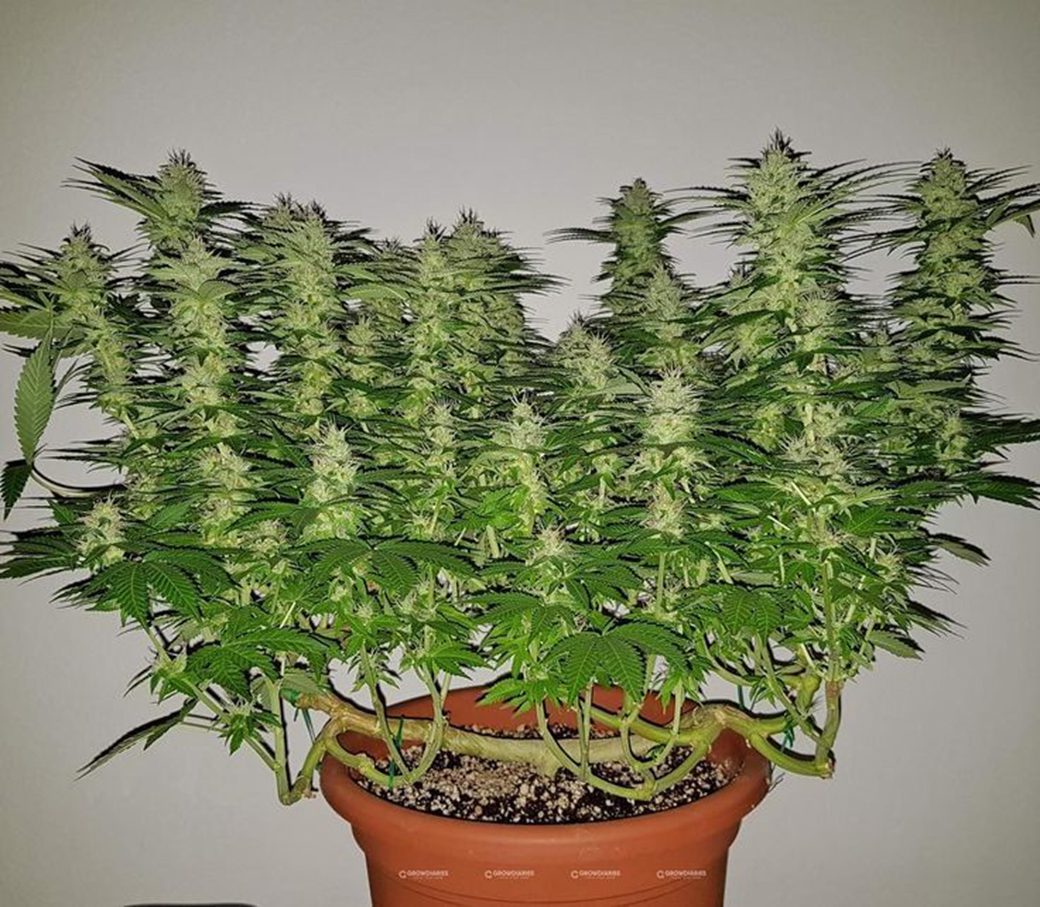
This training requires tying down areas of the plant to create side shoots that will lead to additional cola sites. The primary flower cluster forms along the upper portion of the main stems and large branches in a mature female cannabis plant. (Goggins, 2020)
This method of training is more aggressive, it’s performed by topping or super-cropping to promote a uniform canopy and increased cola sites.
Week 1-3: The plants will be transitioning into flower from their vegetative state; white pistils will start to develop on the plant’s nodes. The plants are still developing stems and leaves as they grow taller.
Week 3-4: The stretching will slow down, and buds will start to develop. The plants will start to uptake nutrients at a faster rate due to the explosive growth. Be mindful of this and keep a watchful eye as nutrient deficiencies can arise in later stages of growth.
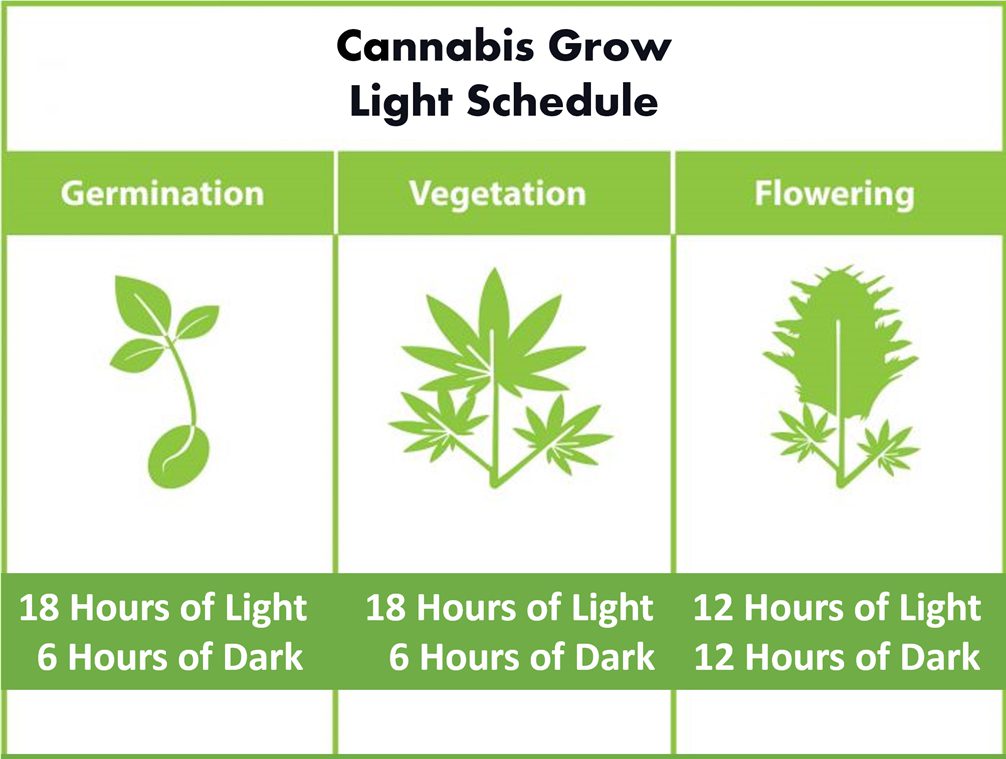
Week 4-6: Stretching has stopped, and the buds have grown exponentially. Flowers will start to gain density and gain a noticeable smell. Feeding regiments are at their peak, and the plants will begin to enter their final stages of flowering. Resin glands will begin to swell, and the process of changing from clear to milky white will begin, indicating a sign of maturity.
Weeks 6-8: The plants have shifted their energy away from growing new leaves and stems, to the bud sites and ripening. The plants’ pistils will begin to change from white to orange and red hues, while the trichomes will continue to turn milky white. Once the majority of trichomes have changed, the plant will be ready for harvest. Feeding regimens should be tampered down, and the flushing process should be started in the final weeks up to harvest.
Since different strains have different flowering periods, trichomes should be inspected with a magnifying glass when determining harvest. The trichome cycle and appearance starts with clear glass-shaped mushrooms, cloudy, then amber. The trick to harvesting is capturing the most trichomes on the overall plant when they are cloudy. However, not all trichomes mature evenly throughout the plant. Typically they mature at the top of the plant and work their way down. When trichomes turn amber, that is an indication that the plant is beginning to over-ripen.
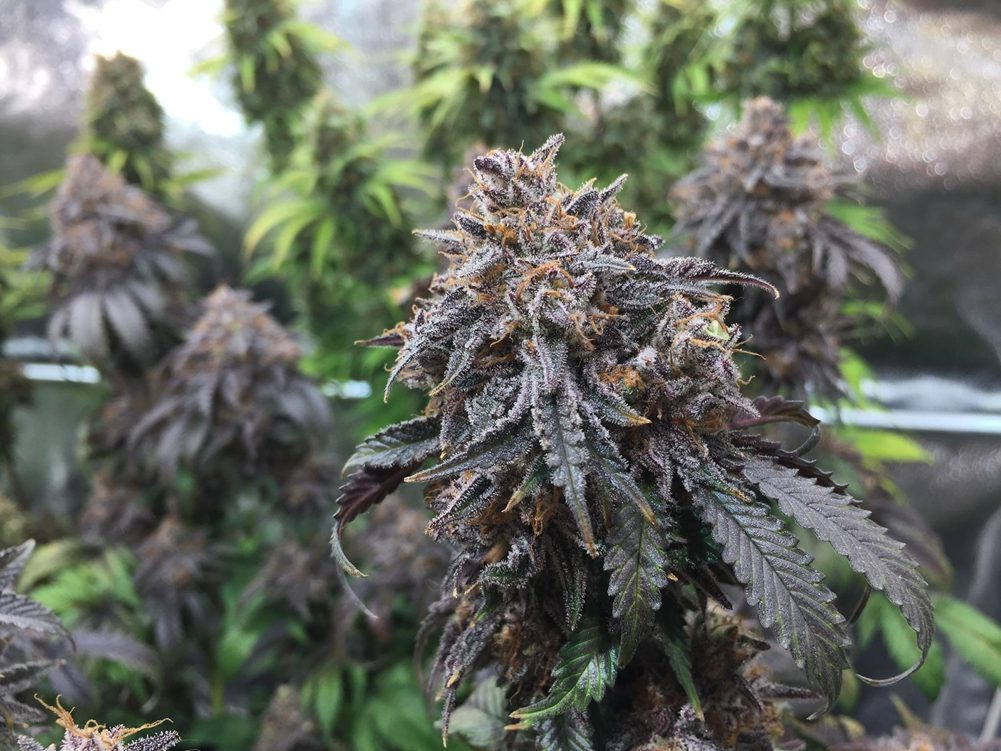
Patience can be the best virtue when it comes to harvesting. The optimal way to harvest cannabis plants is to cut them down in sections, starting with the tops when trichomes are cloudy and just before they turn amber. With the tops cut down, the bottom part of the plant will capture more direct light and allow those trichomes to develop more uniformly from clear to cloudy. This method will most likely extend the harvest period an additional two weeks; however, one will be rewarded with more overall yield and consistent smoking and tasting bud.
However, if one chooses to harvest the crop at once, look to cut down the plants when trichomes exhibit an amber color across 15%-20% of the overall plant mass.
Many individuals and semi-experienced growers view harvest as crossing the finish line. Nothing can be further from the truth. Many novice growers stumble and even fail once they “cut down.” Drying, then curing, is vital to realizing a consummate product. Cannabis can be severely compromised if packaged prematurely. Once harvested, hang plants in a cool dark room with ample ventilation for a period of up to 7-10 days, with temperatures in the 60s to low 70’s and humidity levels around 60-65 percent for maximum terpene preservation. (Cervantes, 2007)
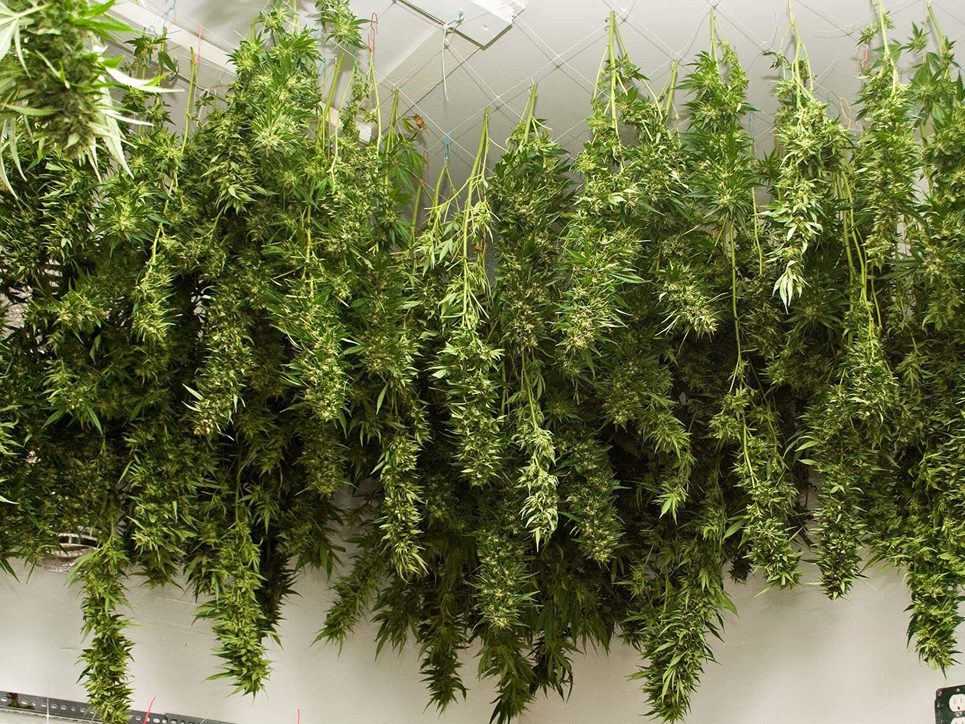
During this time, the buds may dry out to a near crisp. However, that does not necessarily mean it is ready. The stems that they grow on and are attached to retain water still after the bud matter dries. If you subsequently decide to package the bud in a jar, you may find the bud incredibly moist again. Wet or moist bud neutralizes trichome efficacy rendering smoke useless. If left wet in a closed container long enough, buds could rot and mold, effectively ruining the entire stash.
Curing bud requires taking down dried plants between the 7-10 day drying period and placing stalks and stems with attached buds in an enclosed container until buds moisten again. Typically buds will moisten again by the next day. Next, remove the container lid and allow the buds to dry once again. Repeat this process until you can bend the stems to snap; now, the bud has been cured. The entire process could take 2-3 weeks.
Being aware of the climate in which one lives is essential when growing outside. The genetics of cannabis seeds determine how they will perform. Genetics will determine the results even when applying the best nutrient formulation or maintaining a garden to perfection. A more rigorous selection process is necessary for cannabis cultivation outdoors.
The vast majority of cannabis strains on the market today have been bred specifically for indoor cultivation. However, this is not the case with all cannabis varieties. Sun-drenched southern drier climates are ideal for outdoor marijuana growth. There are, however, several outstanding and hardy strains that can be grown at cooler northern latitudes. Below is a handful of genetics recommended for outdoors growing in an often harsh New York City tri-state climate.
Northern Lights stands among the most famous strains of all time, a pure indica cherished for its resinous buds, fast flowering, and resilience during growth. Northern Lights, also known as “NL,” is an indica marijuana strain made by crossing Afghani with Thai. Northern Lights produce euphoric effects that settle in firmly throughout the body, relaxing muscles and easing the mind. Consumers say this strain has a pungently sweet and spicy flavor profile that is smooth on the exhale. Genetics originate from the mountains of Afghanistan, very resilient to colder temperatures.
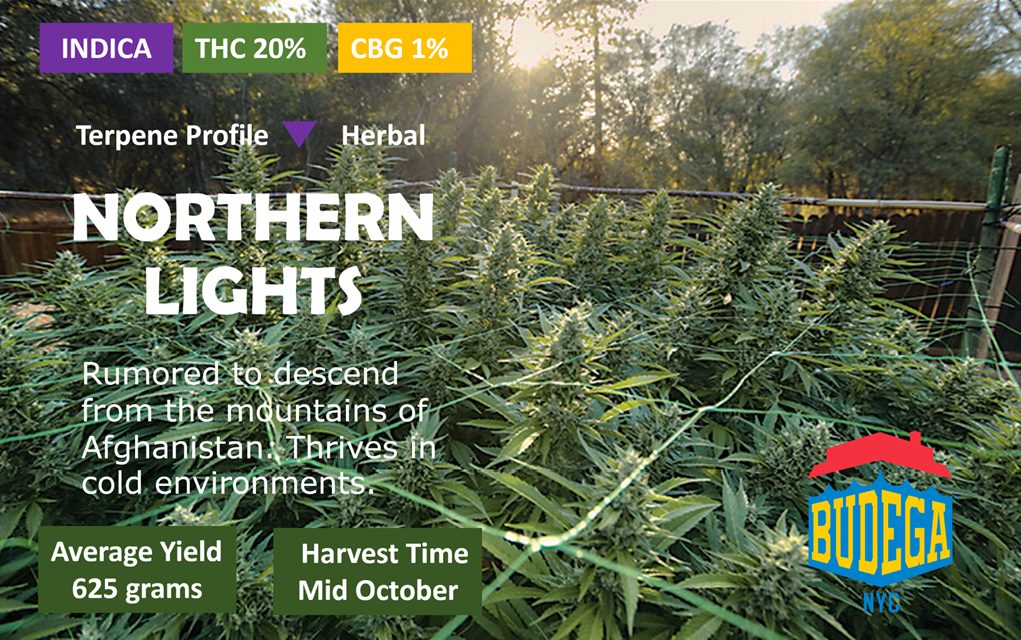
This hybrid strain is among the most famous strains worldwide. A cross between a Brazilian Sativa landrace and a resin-heavy South Indian Indica, White Widow has blessed us with top-shelf quality since the 1990s. Despite it’s geographical roots, White Widow is very suitable to handle the temperamental climate of the North East.
There is an immediate burst of euphoria and energy that stimulates both conversation and creativity. White Widow’s genetics have given rise to many other legends like White Russian, White Rhino, and Blue Widow. Still, many growers prefer the cultivation of the original White Widow, which flowers in about 60 days indoors.
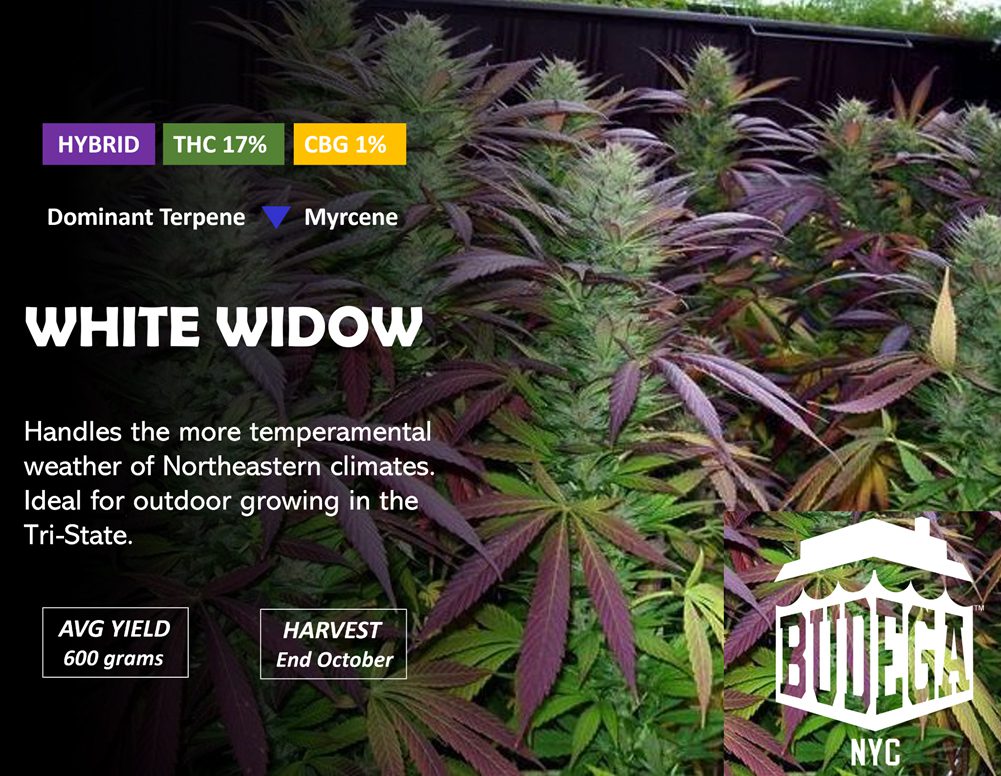
Shining Silver Haze is a cross between Skunk x Northern Lights x Haze, making it significantly easier for beginners to grow than pure Sativa strains. Among her bounty are tall, glistening trichomes and huge sugar leaves.
Its flowers are visibly crystalline with glandular trichomes. Bud-inhabiting structures churn out a THC level of 21% together with a medium level of CBD. She draws on the flavors, aromas, and influences of her ancestors. Her flowers have terpene profiles that produce sweet, citrus, and earthy notes.
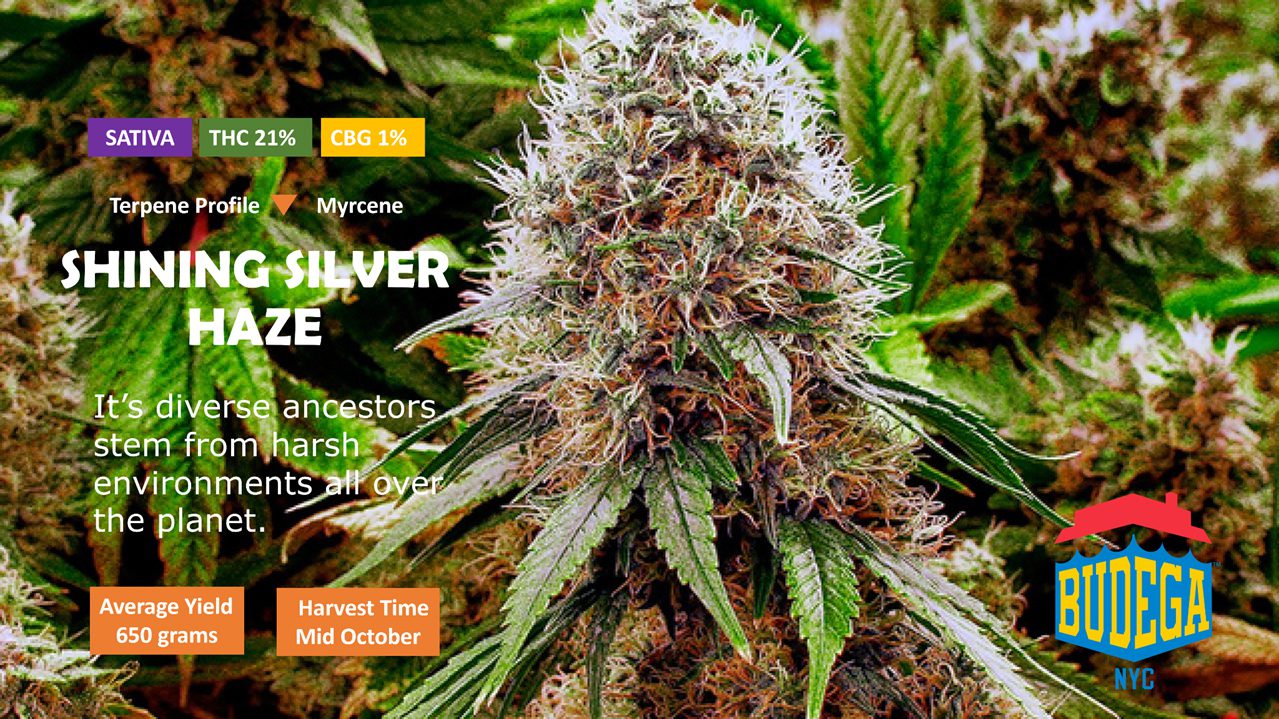
Shining Silver Haze is quite hardy and can tolerate cold weather conditions. Growers located far from the equator will find her an ideal choice.
Despite all the great news about legalization, we all must wait for the state to write the specific regulations that will govern home grows. So no, you cannot grow cannabis at home right now. However, it does not preclude you from making all the necessary preparations to create a successful garden.

